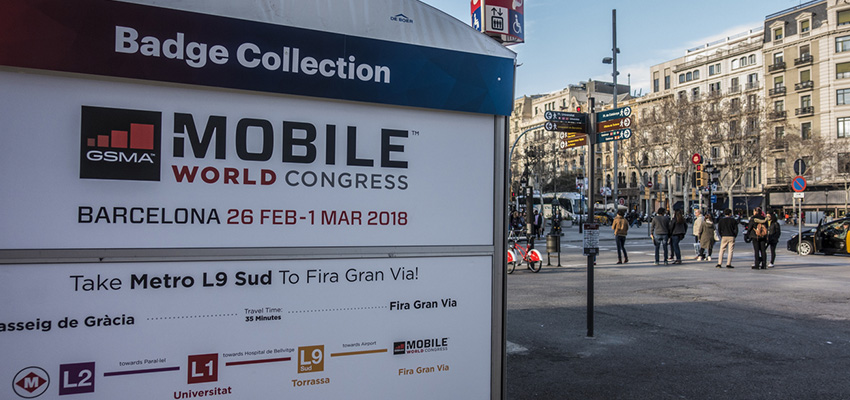
Recapping MWC 2018: Four Things We Would Like to Have Seen
Another Mobile World Congress (MWC) has come and gone. An impressive event as always, this year over 100,000 people descended on an unusually chilly Barcelona for the world’s largest exhibition for the ever-expanding mobile industry to learn about the latest trends and technologies – and to showcase the latest innovations. If one word were to sum up this year’s MWC, it would be “massive.” Not only does this apply to the conference itself, but also to the trends that emerged. 5G is coming with massive, low-latency bandwidth. The Internet of Things (IoT) is taking off with massive amounts of connected devices generating massive amounts of big data to be collected, analyzed, and acted upon.

Despite the hype, however, there were several things we felt were missing from the broader focus to elevate the 2018 conference above others in previous years:
- Tangible use cases of 5G technology. The buzz around 5G has reached epic proportions. Mere months before MWC, the international standards body 3GPP agreed on the first 5G NR (New Radio) specifications, paving the way for 5G delivery to consumers. But while there were a few proofs of concept at MWC, it’s still a touch too early to see any tangible 5G innovation. Talk at the show focused more on the potential for 5G to revolutionize wireless networking infrastructure.
- Artificial Intelligence (AI) beyond robotics. Much of the focus on AI at MWC was how it impacts the robotics industry. However, there is a world of opportunity for Communications Service Providers (CSPs) beyond AI… For example, the rise in connected devices means the rise in big data. This exponential growth in information will require AI solutions to derive actionable insights from big data repositories, along with machine learning to respond intelligently to unforeseen threat and performance scenarios. With the advanced use of AI methodologies, CSPs can better harness big data to gain greater visibility of the network and make better business decisions.
- Mobile security beyond the app-based model. It’s impossible to talk about the flourishing mobile ecosystem without security being at the top of everyone’s minds. And while security was certainly on the agenda at MWC, Allot was one of only a few vendors on hand talking about how CSPs are in a position to offer front-line defense at the network level against mobile attacks. Third-party security apps haven’t taken off, but CSPs can better protect enterprise and consumer customers while generating incremental revenue by providing value-added Security-as-a-Service (SECaaS). This method of security service delivery is becoming even more essential considering IoT device sprawl and the oncoming 5G infrastructure, as it enables CSPs to keep customers safe at home, on public WiFi, and on-net, and has been shown to have adoption rates as high as 50%.
- DDoS was kept in the dark. IoT is exploding and 5G is becoming a reality, but how can CSPs keep enterprise and consumer devices secure and prevent their use in a botnet? DDoS attacks are becoming more powerful than ever. Just recently – right in the middle of MWC – GitHub experienced the largest-known DDoS attack in history, peaking at 1.35Tbps. It wasn’t too long ago that attacks over 1Tbps were unheard of – but we can expect to see many more attacks of this scale in the future. And while 5G promises bigger pipes, the bigger the pipe the greater the risk of DDoS! There was a disappointing lack of attention paid at MWC to the role that CSPs can play to avoid blacklisting and eliminate traffic overload to maintain network efficiency, assure Quality of Service (QoS), and protect subscribers.
 It is against this backdrop that it was particularly important to launch our new Allot Secure security services delivery platform at MWC this year. When it comes to the next big thing like 5G, IoT, and AI, among others, Allot believes a consolidated and unified approach to security services delivery is essential to combat evolving cyber threats. It is imperative to keep in mind that the success of these technologies in the telecom arena is greatly dependent of the ability to:
It is against this backdrop that it was particularly important to launch our new Allot Secure security services delivery platform at MWC this year. When it comes to the next big thing like 5G, IoT, and AI, among others, Allot believes a consolidated and unified approach to security services delivery is essential to combat evolving cyber threats. It is imperative to keep in mind that the success of these technologies in the telecom arena is greatly dependent of the ability to:
- Collect and analyze detailed network, application, and user data to enable accurate and timely business decisions
- Manage network traffic to detect and prevent performance degradation and security threats before customers are impacted
- Deliver security to anyone, anytime, anywhere
To learn more about how CSPs can deliver branded, centrally-managed, multi-tenant security services, check out Allot Secure for CSPs. See you at MWC Americas in LA in September!


